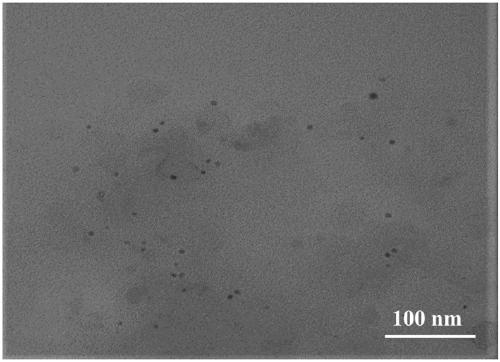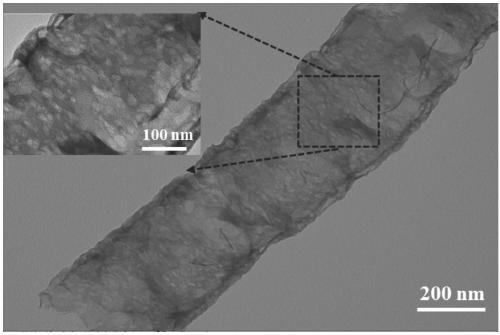Sulfur-doped g-C3N4/C-dot porous composite photocatalyst and preparing method and application thereof
A C3N4, c-dot technology, applied in the direction of physical/chemical process catalysts, chemical instruments and methods, chemical/physical processes, etc., to achieve the effect of increased specific surface area, low cost, and increased specific surface area
- Summary
- Abstract
- Description
- Claims
- Application Information
AI Technical Summary
Problems solved by technology
Method used
Image
Examples
Embodiment 1
[0045] A sulfur-doped g-C 3 N 4 The preparation method of / C-dot porous composite photocatalyst comprises steps as follows:
[0046] (1) By stirring and mixing melamine and thiocyanuric acid, sulfur-doped C 3 N 4 (S-C 3 N 4 )Precursor:
[0047] Dissolve melamine and thiocyanic acid in equal molar ratios in hot water at 90°C and mix evenly for 10 minutes, then mix the two and transfer them to a polytetrafluoroethylene reactor for hydrothermal reaction. Specific conditions: put the reaction kettle in an oven at 100°C for 4 hours, take it out after cooling, wash it with deionized water several times, and then put it in an oven to dry to obtain S-C 3 N 4 precursors.
[0048] (2) carbonization of carbon-containing organic matter by alkali-assisted ultrasonic method to obtain C-dot nanoparticles:
[0049] Dissolve 9g of glucose in 50mL of deionized water, stir until it forms a clear solution, then add 0.8g of sodium hydroxide and stir to mix evenly. The ultrasonic time is ...
Embodiment 2
[0056] A sulfur-doped g-C 3 N 4 The preparation method of / C-dot porous composite photocatalyst comprises steps as follows:
[0057] (1) Sulfur-doped g-C was prepared by stirring and mixing melamine and thiocyanuric acid 3 N 4 (S-C 3 N 4 )Precursor:
[0058] Dissolve melamine and thiocyanic acid in equal molar ratios in hot water at 90°C and mix evenly for 10 minutes, then mix the two and transfer them to a polytetrafluoroethylene reactor for hydrothermal reaction. Specific conditions: put the reaction kettle in an oven at 100°C for 4 hours, take it out after cooling, wash it with deionized water several times, and then put it in an oven to dry to obtain S-C 3 N 4 precursors.
[0059] (2) C-dot nanoparticles were obtained by carbonizing carbon-containing organic matter by alkali-assisted ultrasonic method: Dissolve 9 g of glucose in 50 mL of deionized water, stir until it forms a clear solution, then add 0.8 g of sodium hydroxide and stir to mix evenly , and the obtai...
Embodiment 3
[0064] A sulfur-doped g-C 3 N 4 The preparation method of / C-dot porous composite photocatalyst comprises steps as follows:
[0065] (1) Sulfur-doped g-C was prepared by stirring and mixing melamine and thiocyanuric acid 3 N 4 (S-C 3 N 4 )Precursor:
[0066] Dissolve melamine and thiocyanic acid in equal molar ratios in hot water at 90°C and mix evenly for 10 minutes, then mix the two and transfer them to a polytetrafluoroethylene reactor for hydrothermal reaction. Specific conditions: put the reaction kettle in an oven at 100°C for 4 hours, take it out after cooling, wash it with deionized water several times, and then put it in an oven to dry to obtain S-C 3 N 4 precursors.
[0067] (2) C-dot nanoparticles were obtained by carbonizing carbon-containing organic matter by alkali-assisted ultrasonic method: Dissolve 9 g of glucose in 50 mL of deionized water, stir until it forms a clear solution, then add 0.8 g of sodium hydroxide and stir to mix evenly , and the obtai...
PUM
| Property | Measurement | Unit |
|---|---|---|
| diameter | aaaaa | aaaaa |
| size | aaaaa | aaaaa |
Abstract
Description
Claims
Application Information
 Login to View More
Login to View More - R&D
- Intellectual Property
- Life Sciences
- Materials
- Tech Scout
- Unparalleled Data Quality
- Higher Quality Content
- 60% Fewer Hallucinations
Browse by: Latest US Patents, China's latest patents, Technical Efficacy Thesaurus, Application Domain, Technology Topic, Popular Technical Reports.
© 2025 PatSnap. All rights reserved.Legal|Privacy policy|Modern Slavery Act Transparency Statement|Sitemap|About US| Contact US: help@patsnap.com



